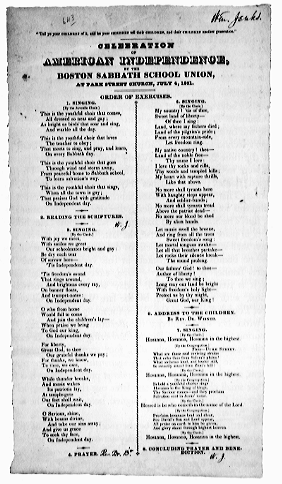Dartmouth College Library Bulletin
A SONG seldom heard today, though sung lustily by so many grammar-school boys and girls of this writer's generation, is 'America,' or 'My Country, 'Tis of Thee.' As a matter of fact, the last time I heard it sung was by a group of children on a telecast at the time of Ronald Reagan's second inauguration as president of the United States. At about the time of the Second World War, various other patriotic songs were frequently substituted:the national anthem, `The Star-Spangled Banner'; the 'Marines' Hymn'; and occasionally 'Hail Columbia.' Then we all heard Kate Smith belt out 'God Bless America,' and this song was ours; it nearly became the new national anthem. But 'The Star-Spangled Banner' remained. Some churches substituted, in place of the first verse, the last, `O thus be it ever when freemen shall stand/Between their lov'd home and the war's desolation!' -- no bombs and red rockets in this verse. Today the 'Star-Spangled Banner' is infrequently sung, except at baseball games, where it is frequently botched. Today we all sing 'America the Beautiful,' with verses written by the late Wellesley College Professor of English Katharine Lee Bates, for many occasions. Professor Bates wrote her song 'America the Beautiful' after visiting Pike's Peak during the summer of 1893, remembering the 'sea-like expanse of fertile country.'1 On 4 July 1895, four stanzas of 'America the Beautiful' were published in the Congregationalist. In 1904 she rewrote the poem, and the Boston Evening Transcript published it in this form. A further small change a few years later put the song into its final form. Special Collections owns a signed holograph of the second stanza of 'America the Beautiful.'

The Fourth of July, 1991, Will be the 60th anniversary of the first public singing of 'America,' by Sunday- school children at the Park Street Church in Boston, for which occasion the poem, by Samuel Francis Smith, was first printed. This Library has one of only a few known copies. Dartmouth's copy is the one used by the Reverend Dr. William Jenks when he conducted the first singing of 'America' and is signed by him at the top of the broadside. The broadside measures 30 by 16.5 centimeters and includes on the verse notes in Dr. Jenks's own hand.
Samuel Smith was a Baptist minister and a member of the Class of 1829 at Harvard and the Class of 1832 at Andover Theological Seminary. During his course work at Andover, he was asked to assist in writing verses for a song book to be used in schools. In February 1831, inspired by the tune of a patriotic German song, Smith later recalled, 'I . . . instantly felt the impulse to write a patriotic hymn of my own to the same tune. Seizing a scrap of waste paper, I put upon it, within half an hour, the verses substantially as they stand to-day.'2 The tune that had itself inspired the German verses had been published in England in 1744, with the first line reading 'God save our Lord the King,' later changed to 'God save our gracious king.' The song soon became popular and in time was accepted as the national anthem of Great Britain.
David J. Fant, in a leaflet distributed by the Park Street Church to the public today, quotes from Smith's classmate, Oliver Wendell Holmes, referring to the 'My' in 'My Country, 'Tis of Thee.' Holmes said that 'That little pronoun did it all, and will forever do it.... Why couldn't any of the rest of us have thought of that? That puts America in the hearts of the people, and because of it Sam Smith will live when Longfellow and Whittier and all the rest have gone into oblivion.' While these two venerable poets have obviously not faded into oblivion, 'America' does still live on.
1. Dictionary of American Biography, supplement one, article on Bates.
2. Quoted in the Dictionary of American Biography article on Smith (various editions).